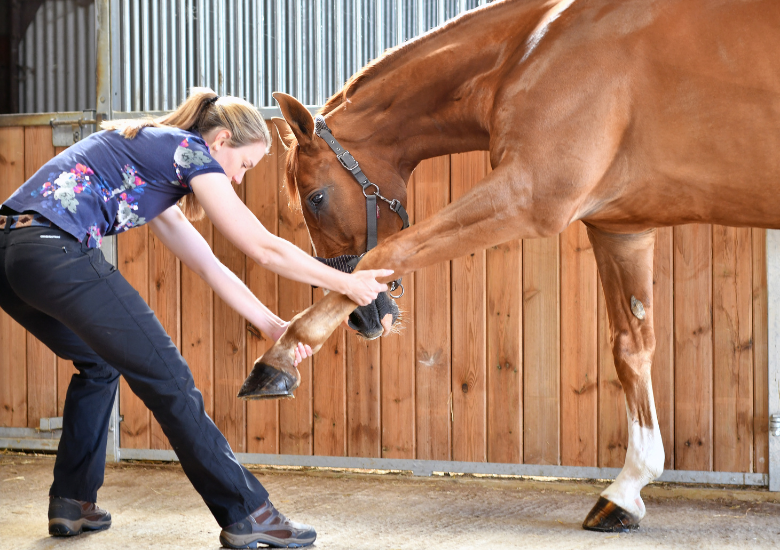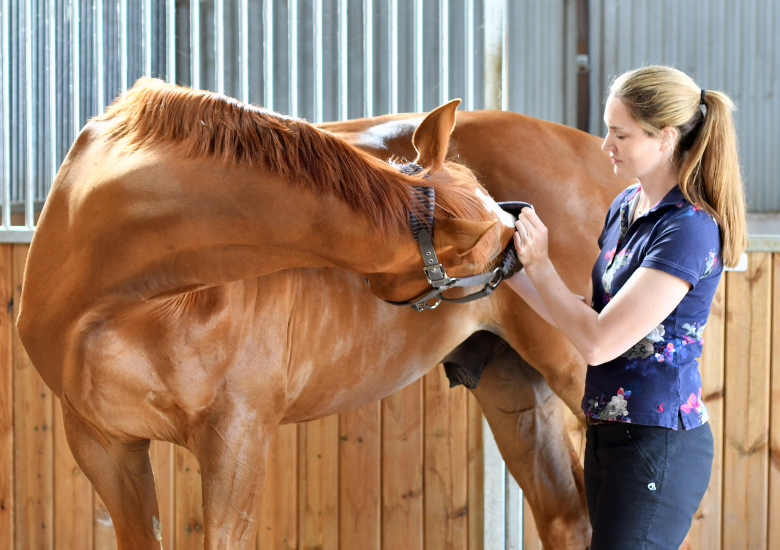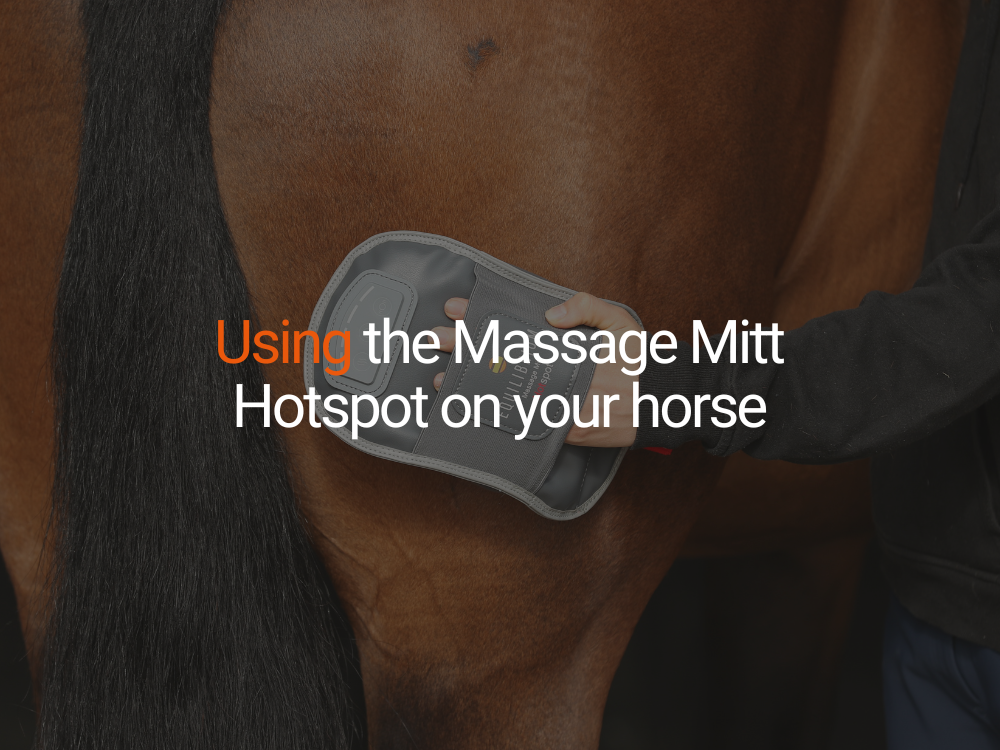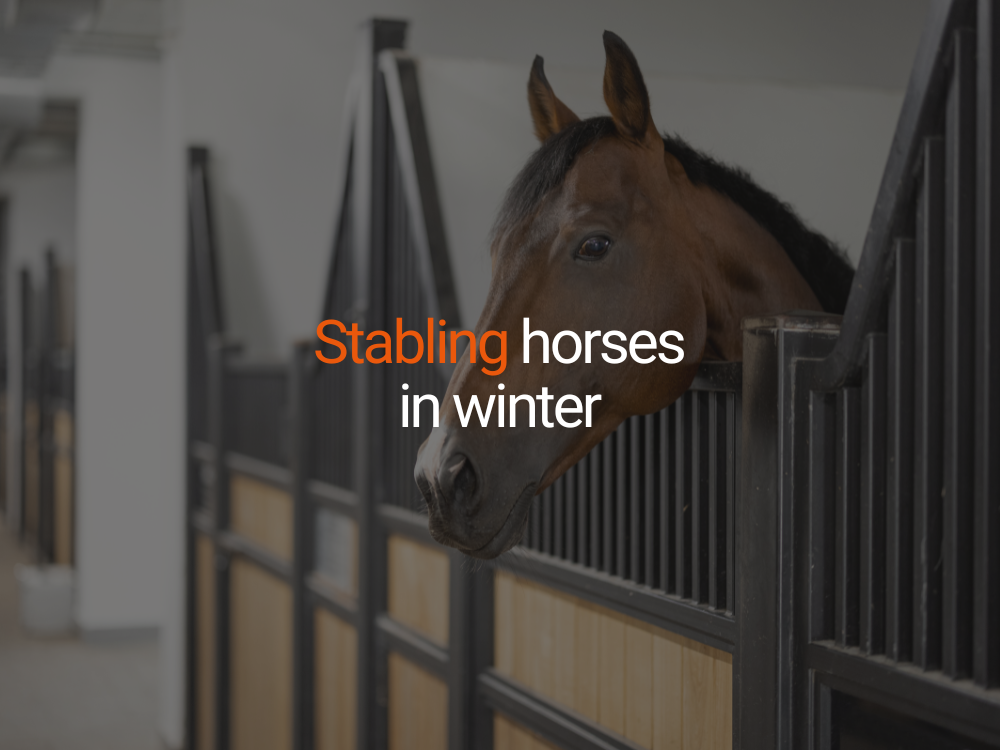
Passive Stretches

Baited Stretches of the Head and Neck

Spezielle Bestellanweisungen
Pferdebekleidung
Pferdebekleidung
Therapie
Pferdestiefel
Sonne & Flug
Halfter & Führstricke
Teppiche
Reitzubehör
Ernährung
Ernährung
Futter- und Heublöcke
Leckereien
Haynets
Bucket Covers
Shop by Pet
Reichweite
Additional B2B Information
Additional B2B Information
Disziplin
Bildungszone
We’re still dispatching orders between Christmas and New Year, but courier delays may mean your delivery takes a little longer.
See our Delivery Information page for details.Stretches should only be carried out once the muscles have been warmed up. After exercise is the best time to stretch your horse, alternatively using the Equilibrium Massage Pad and the Massage Mitt on key areas, such as the neck, shoulders and quarters can help to warm the muscles up. Stretching a cold muscle increases the risk of damage to the muscle fibres as they are less elastic and can tear more easily.
Stretching regularly has many benefits, including:
Listed below are 10 simple stretches that you can do with your horse on a regular basis to help keep them supple though their top line, encourage a good stride length and improve neck flexion.

Fore limb Protraction
Pick up the horses’ foot as normal and then gradually draw the limb forward supporting the fetlock joint and flexor tendons. Hold for 30 seconds and repeat 3 times on each leg. If your horse is snatching the leg back, reduce the amount of stretch and build up gradually each day. This will stretch the triceps, lattisimus dorsi and other muscles involved with forelimb movement.
Hind limb Protraction
Draw the horses’ hind limb forwards toward the forelimb fetlock; make sure you keep the leg in a straight line rather than pulling the limb away from the body. Again, hold for 30 seconds and repeat 3 times on each leg. This will stretch the hamstring muscle group.
Lateral Extension of Spine
Place one hand on the wither and the palm of your other hand on the point of hip. GENTLY place pressure on the point of hip in a straight line towards the back of the horse. Hold for 30 seconds and repeat 3 times on each side. Some horses may find this one more difficult than others, take your time and increase the stretch slowly. If your horse tries to move away, ask for less stretch. If the muscles of the back are twitching hold the stretch and don’t ask for any more until this has stopped. Severe twitching may suggest your horse is in a bit more discomfort and would benefit from a once over by your vet.
Back lift
Run your finger tips down the crease in the muscles on your horses’ hind quarters, to encourage you horse to tilt their pelvis and lift through the lumbosacral region. ‘Tickle’ the area to try and maintain the lift for 15 seconds, repeat 3 times. Don’t try this one if you know your horse can be a bit handy with their back legs!

These baited stretches are really easy to achieve using the high value, low sugar treats, Crunchits. This way you don’t need to worry about how many treats your horse is having. With each of these stretches try to maintain the position for 10-15 seconds before giving the treat and repeat this 3 times on each side. Maintain smooth movements without any snatching or grabbing; if your horse is having to try and grab it may mean you’re asking too much too soon, reduce the stretch and build up gradually. Try to ensure your horse is stood as square as possible for all these stretches

1. Take the crunchit between the front legs close to the ground. This will stretch the muscles of the neck and back that make up the top line.
2. Take the crunchit between the horses’ front legs, ensuring he doesn’t start to twist at the poll. This will encourage greater flexion of the neck muscles, the poll, and cervical vertebrae.
3. Bring the crunchit around to the side to encourage lateral flexion. Aim for the horses’ shoulder.
4. From lateral flexion bring the crunchit down to ground level to stretch the muscles closer to the wither – these muscles are particularly important for self carriage.
5. Take the crunchit round to the flank to get an even greater lateral stretch.
6. Finally bring the crunchit forwards, trying to keep the neck horizontal and in line with the back to get full neck extension. Place your other hand on his shoulder to stop him from taking a step forwards and cheating!

Wie sicher ist das Halfter Ihres Pferdes?
Halfter gehören zu den am häufigsten verwendeten Ausrüstungsgegenständen für Pferde. Tatsächlich verwenden 88 % der Besitzer täglich ein Halfter*. Als Reiter haben wir Sicherheitsausrüstung, um uns zu schützen, wie Stiefel, Hüte und Körperschutz. Dies dient natürlich dazu, Verletzungen oder schwere Verletzungen im Falle eines Unfalls zu verhindern. Aber müssen unsere Halfter auch sicher sein? Wir haben unser Stellar-Halfter nach der Untersuchung von Halfterunfällen entwickelt. Lesen Sie weiter, um herauszufinden, was wir herausgefunden haben.

Verwenden Sie den Hotspot-Massagehandschuh bei Ihrem Pferd
Dieses „handliche“ Handgerät bietet sowohl Massage als auch Wärme für Pferde und ihre Besitzer/Reiter und kann auf viele verschiedene Arten verwendet werden. Laden Sie den Akku auf, sodass die Lampe am Ladegerät grün leuchtet, und schon kann es losgehen!

Stallhaltung von Pferden im Winter
Die Pferdepflege im Winter kann hart sein, egal ob Sie Ihre Pferde im Stall unterstellen, sie auf die Weide lassen oder einfach nur reiten möchten! Wir haben ein paar Tipps für die Pflege Ihres Stallpferds im Winter zusammengestellt, was einige Herausforderungen mit sich bringt.
Melden Sie sich für unsere Mailingliste an, um Updates zu unseren Produkten, Verkäufen und exklusiven Prämien zu erhalten
Verbinde dich mit uns
© 2025,
Equilibrium.Copyright © 2024 Equilibrium Products Limited. Eingetragen in England und Wales Nr. 03762996.
Wir verwenden Cookies und ähnliche Technologien, um die bestmögliche Erfahrung auf unserer Website zu bieten.
